Perhaps one of the biggest misconceptions when it comes to owning fish, starting a community, and managing a vibrant aquarium is that most colorful fish hail from saltwater, and hot, tropical climates.
This could not be further from the truth, you certainly do not need tropical fish from salty pastures to brighten up your aquarium. There are an abundance of incredibly beautiful and uniquely colored aquarium fish that live and thrive in freshwater.
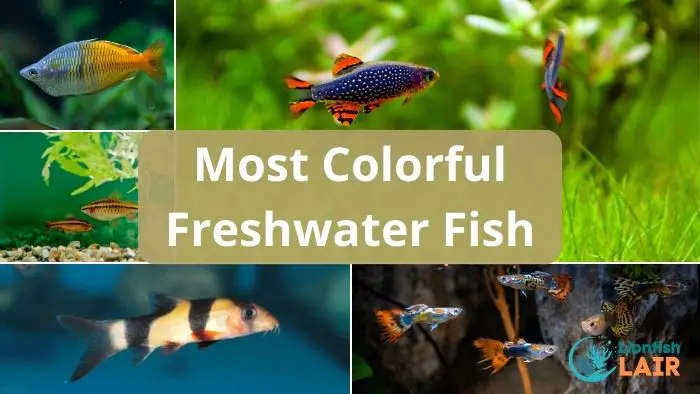
Did you know, not only do aquariums provide much entertainment for hobbyists, but sitting back, relaxing, and watching brightly colored community fish majestically navigate around a tank lowers stress levels and has been known to increase one's productivity, as well as slowing down your heart rate and blood pressure!
For the majority of people, a colorful tank is always the dream. Why would you not want to own exciting fish all boasting unique patterns and characteristics. However, the affordability of a saltwater environment, with the corals, and reef equipment can get extremely pricey, and that's without mentioning the price of most saltwater fish!
It seems like many people forget, or just simply disregard freshwater aquarium fish under the assumption that they simply are not as colorful as saltwater fish. This is not the case, and in this article, not only are we going to debunk this theory, but we also detail and describe some of the most colorful and charismatic freshwater fish out there, for beginners, and experts alike.
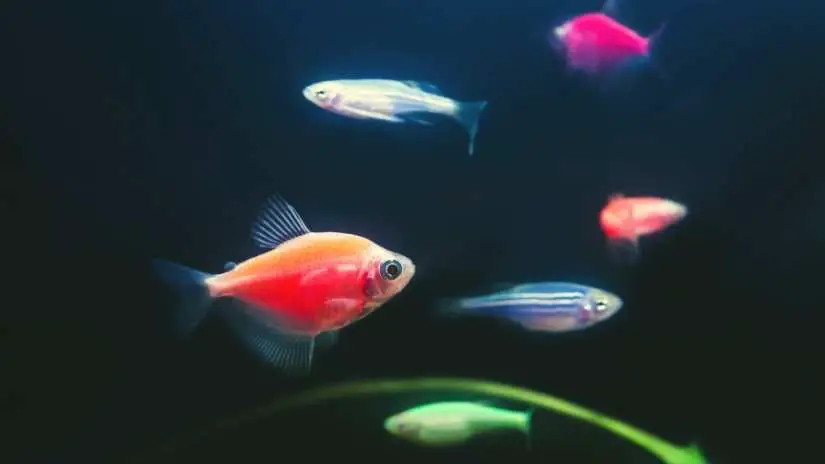
Bear in mind that this list is our Top 10 Most Colorful Freshwater fish, and in addition to these, there are many other incredibly colorful and amazing freshwater tropical fish that didn't make the list.
It really doesn't matter if you are planning or already own a wall-sized mega-aquarium, or simply a small sanctuary with just a few members of the community, this list consists of at least one colorful tropical freshwater fish that is perfect for you and your aquarium community.
1. Boesemani Rainbow (Melanotaenia boesemani)
These unusual, yet beautiful looking fish species certainly live up to their name, displaying an array of silvery-blue at the beginning of their bodies, and then a bright, neon kind of orange encompassing the rest of the body, and the tail. For rainbow fish, this pattern is extremely uncommon.
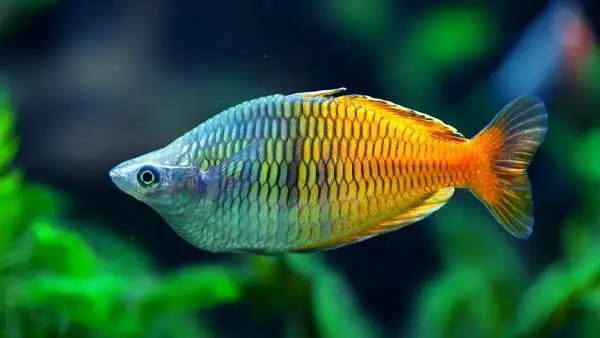
This species in particular hails from the Ayamaru Lakes of Indonesia, where they enjoy living in heavily planted areas of the freshwater lakes. The warm climate suits them perfectly, and the sunlight brings out their stunning array of colors. The Boesemani Rainbowfish also tends to enjoy the shallow waters to avoid potential run-ins with predators who lurk in the deeper regions of the lakes.
Boesemani Rainbow Fish Overview
The fish itself will grow to around 4 inches in length (10 cm), they are incredibly peaceful by nature and are very social fish. Keeping them in schools of 8 or more is most ideal, so make sure you have a big enough tank to accommodate them. Unfortunately, like many rare freshwater fish, especially ones as glorious as this Rainbow, they certainly aren't cheap, however, we believe they are totally worth saving up for!
Changes in the water quality is not recommended with these guys, they react pretty badly when this situation occurs so make sure to keep constant maintenance going. However, if the conditions worsen, you will likely see your fish drift to the bottom of the tank, keeping their fins clamped to their sides - this is how you can tell the water quality needs improving quickly.
Boesemani Rainbow Fish Key Points
- Easy fish to manage for all experience levels.
- They are incredibly peaceful and well-natured.
- They are Omnivores.
- The recommended tank size is 40 Gallons which is 151 liters.
2. Celestial Pearl Danio (Celestichthys margaritatus)
Just to add to general fish confusion, the Celestial Pearls are often referred to using another name, "Galaxy Rasboras", which is fine, the only issue is that they do not actually belong to the Rasbora family, so try not to get confused.
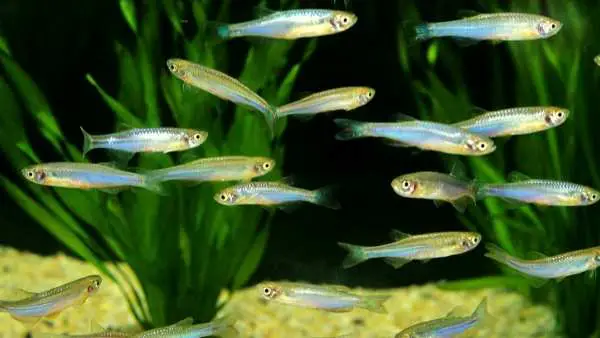
These fish are tiny in size, only around 1 inch in length (2.5 cm), but their coloration really helps with them standing out. They are covered in deep blue scales, with bright, almost fluorescent spots that resemble the shiniest pearls, both of their fins and tails are a bright orange color and with almost ink-black stains on the ends.
Celestial Pearl Danio Overview
The Pearl Danio's make for a brilliant addition to any sized tank, especially if you are a beginner with a nano-sized aquarium looking for some small fish but colorful. However, they are certainly creatures of habit, so don't expect them to be moving around the tank too often. In fact, they mainly hover around the bottom of the tank, just above the seabed. So, if you would like the middle space of your tank occupied, it would be a good idea to get some other colorful fish to fill in the middle area too.
These critters are incredibly peaceful, especially when it comes to other species of fish. However, due to the males being more colorful than the females, many people make the same mistake of overrunning the tank with primarily males. This is when things can get a little complicated! They are peaceful fish, but with a caveat. If there are too many males in one tank, they will fight one another, and sometimes to the death. To keep the peace, we advise more females than males.
Celestial Pearl Danio Key Points
- They are an easy fish for beginners or experts.
- They have a peaceful temperament, (especially with different fish) unless there are too many males.
- They are omnivores.
- The ideal tank size for these fish is 10 gallons, or 38 liters.
3. Cherry Barb (Puntius titteya)
Ironically, the Cherry Barbs do not always display that "cherry red" vibrant and awesome color, the majority of the time they will be seen with a silver color dominating their bodies. Funnily enough, it is only really during breeding season that the males are seen with the bright red color, to attract the female Cherry Barbs.
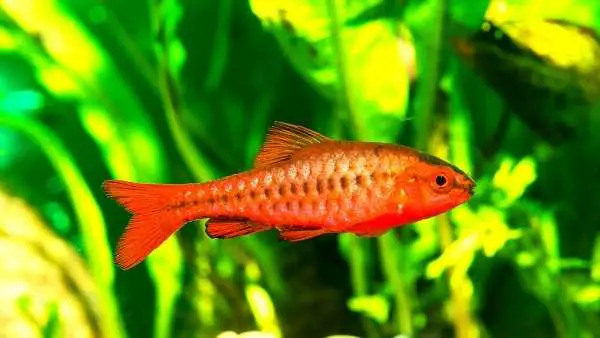
To say that the Cherries are highly strung would be putting it lightly! These fish need constant entertainment or else they will start behaving badly, darting around the tank, acting skittish and erratic. The best way of providing this is to keep them in schools or large groups of Cherry Barbs, and also adding tank additions such as plants, this will put the rest of your community at ease as well as the Barbs. However, you want to avoid totally overcrowding your tank, they still need plenty of room to swim around and places to hide.
Cherry Barb Overview
Once the environment has been prepared then you will be ready to acquire your own Cherry Barbs. It is, however, important to be a fairly experienced hobbyist as they do require a little more care and attention than the fish listed above.
The difficulty level ranges between easy and hard, experience is recommended, however, if the research has been done and you are confident, we don't see why you can't take the plunge!
Cherry Barb Key Points
- Their temperament is peaceful, they make for ideal tank mates.
- They are omnivores.
- The ideal tank size is 20 Gallons which is 76 Liters.
4. Clown Loach (Chromobotia macracantha)
The Clown Loaches are an awesome addition to any hobbyist community, boasting some incredibly vivid orange and black stripes along their bodies, they truly are some of the most unique freshwater fish out there. Another redeeming quality is that they are not aggressive fish by nature and don't have the same bullying tendencies as other loaches do.
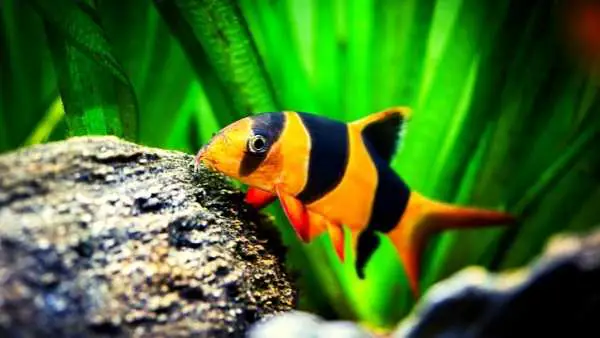
It is important to understand the mature size of these fish. While they may start out small, or normal sized for the first 10 years or so of their life, they will grow to around 12 inches (30 cm) as fully-grown adults. What also adds to this is that they need to be in schools of minimum 6 to prevent stress and boredom, which only means one thing, you need a pretty big tank. They will also stick around for a long time, some have reached 30+ years old.
Clown Loach Overview
With these fish it really is a marathon, not a sprint. You will often see many fish come and go from your aquarium as the years roll on and your experience sharpens, however, the Clown Loaches will be there for the majority of time.
The difficulty level is moderate to high for these fish, mostly due to the fact that they grow pretty big, and bigger fish do require more work and experience. The likelihood is that you will have an established tank that is big in size, as an experienced hobbyist, and then add these as a bright and cheerful addition!
Clown Loach Key Points
- They are an incredibly peaceful and will be a model citizen of your community.
- They are omnivores.
- The recommended tank size is anything 100 Gallons or higher, which is 379 Liters.
5. Endler Livebearer (Poecilia wingei)
The Endler Livebearer, which is known by many as the Poecilia Wingei sports an array of incredibly colorful patterns, it truly is a sight to behold. Not only are the colors and patterns of this fish unique, but the shape of their bodies too.
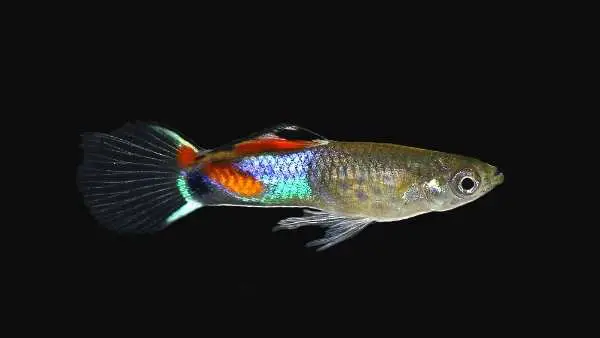
The most popular, or at least one of is the Red Flame Endler, which boasts red, green, and teal colors, however, there are so many different variations of color that come with this species, there is an abundance of options. Fortunately, or unfortunately (whichever way you look at it), they are only around 1 inch long, which is 2.5 cm at full maturity.
Endler Livebearer Overview
Large tanks will certainly not be necessary, not only because they are small in size, but because they are not interested in living in schools. The maximum recommendation would be a pair of them together, but any more than that would not be advised.
Despite displaying amazing, and varied coloration, and having a peaceful temperament, they do require harder water than the majority of freshwater fish, especially the ones that have made this list today. Which does make adding them to a pre-existing, or even a new community a struggle.
Endler Livebearer Key Points
- The difficulty level is easy for looking after them, beginners and experts will have no problem with them.
- They are peaceful by nature and make for excellent community members.
- They are omnivores.
- They are so small and do not need to be in a school that they could literally live in a 2 Gallon tank (7.5 liters) and be happy and healthy.
6. Fancy Guppy (Poecilia reticulata)
Fancy Guppies hold a pretty hilarious name, unfortunately their official name is actually Fantail Guppies, but we prefer the "Fancy Guppies", and believe it is more suitable. They truly are fancy, and one of the most beautiful fish to enter our list with their somewhat Peacock-like tail that spreads out, showing off its multitude of shiny colors.
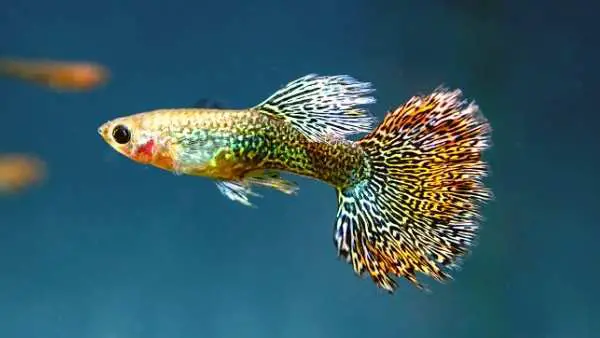
Much like the name, their coloration is unique too, as they come in every color you could imagine and often display amazing patterns too. Another redeeming quality is their size, only growing to around 2.5 inches in length (6.4 cm). They do, however, enjoy being in schools, but you won't need to go crazy with the amount - 3 or more is recommended.
Fancy Guppy Overview
They are very well-natured, and if you want to avoid babies, stick to a strictly male group, they are not only brighter in color, but they don't fight each other either. The Guppies are full of personality too, they are incredibly intelligent and inquisitive little fish and will definitely swim up to the tank upon anyone's arrival purely out of nosiness.
Fancy Guppy Key Points
- They are an easy species to own, perfect for beginners!
- They are peaceful and non-aggressive.
- They are omnivores.
- The tank size required would be 5 Gallons (and up) or 19 Liters.
7. Glowlight Danio (Danio choprae)
The Glowlight Danio are only a recent addition to aquariums and hobbyists alike, announcing themselves onto the scene as a green, gold, red, and turquoise patterned fish with a big personality that will only be a benefit to your community. They are still in their infancy when it comes to being a pet, therefore it may be tough to find them and when you do, expect a rather large price tag.
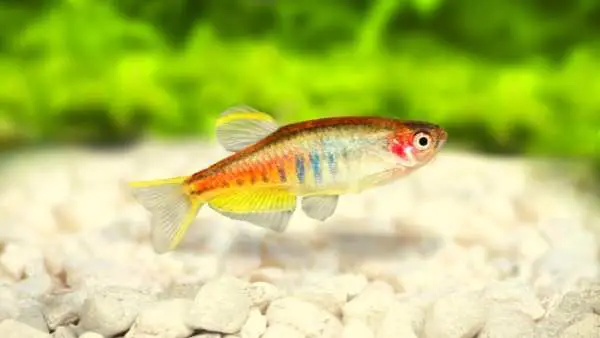
The main reason for the price being so high is that they only made it to aquariums in 2003, and they can only be found in one location - the Irrawaddy River of Myanmar, which is situated in Burma. There are many captive-breeding projects currently in operation, however, the process is still pretty slow.
Glowlight Danio Overview
A frustrating aspect of these incredible Glowlights is that they swim in schools of 10+, preferably 20, and when it is already a tough task even locating them, this adds to the process. They have an awesome personality and are peaceful and harmless, they will be good company for the rest of your community.
Glowlight Danio Key Points
- They are easy to manage and perfect for any level of hobbyist.
- They are extremely peaceful and have are good natured.
- They are omnivores.
- Best tank size would be anything 20 Gallons or more (76 Liters).
8. Killifish
Killifish are an awesome addition to any tank or community, and you only have to pick from 1270 different species, so it isn't too hard! The good thing is that they all come in incredible colors and patterns, they also come from all over the world, from Africa, Asia, and North America to Europe and South America too, with each region requiring different adaptations.
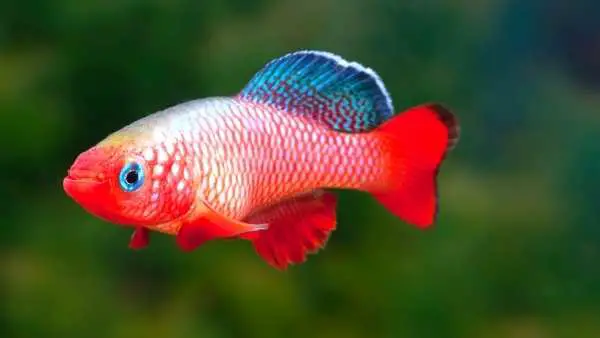
These fish provide much entertainment and are high-energy, which is great. However, you will need to watch out and securely fasten your tank lid, as they are active swimmers and have a reputation for jumping. It is also best to keep one male in per school as some species have been known to be aggressive at times and the males will likely get territorial.
Killifish Overview
- They are between easy and moderate in terms of how hard they are to keep, OK for beginners but not ideal.
- The males can be aggressive depending on the species.
- They are omnivores.
- Depending on the species, the tank size will differ, however, the average should be 20+ Gallons (76 Liters)
9. Platy (Xiphophorus maculatus)
The Platies come in an abundance of different colors, however, it's the Red Wagtail Platy that has become a favorite amongst hobbyists. It is a good idea to look around at all of the options though as another colored Platy might suit your aquarium's coloration better.
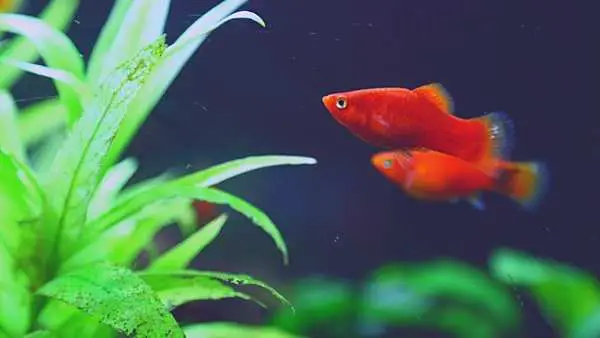
Platies are small fish, only hitting around 2 inches in length (5 cm), they are flat in shape and have rather larger (comparatively) fan-shaped tails. They are a fairly active fish and enjoy swimming in schools. It isn't recommended for them to live alone or in couples, they do however, thrive within community tanks and are a model citizen.
Platy Overview
To showcase their array of beautiful colors it might be a good idea to look at pairing them with another school of fish with a similar peaceful nature, Mollies or Guppies are always a good option. Despite being predominantly omnivores, they do tend to eat a herbivore diet a lot of the time too. The key is to mix in meats like shrimp to a heavy plant-based diet in order to see you Platy live a strong and healthy life, keep an eye on your tank plants though!
Platy Key Points
- They are an easy fish to keep, perfect for beginners.
- Peaceful by nature, and the perfect tank mate.
- They are omnivores but prefer a plant-based diet.
- The ideal tank size would be 10 Gallons, or 38 liters, mostly due to them preferring to live in schools.
10. Royal Blue Danio (Danio kerri)
The Royal Blue Danio is an interesting fish, to say the least. They have a glistening silvery blue body that shimmers underneath the light, accompanied by vibrant yellow lines that run lengthways across them. They are a busy, community-based fish and require living in schools, they say 8 is an absolute minimum as they do develop stress, fortunately they are only a very small species of fish, growing to around 1.5 inches (3.8 cm), so, the larger the group the better with these.
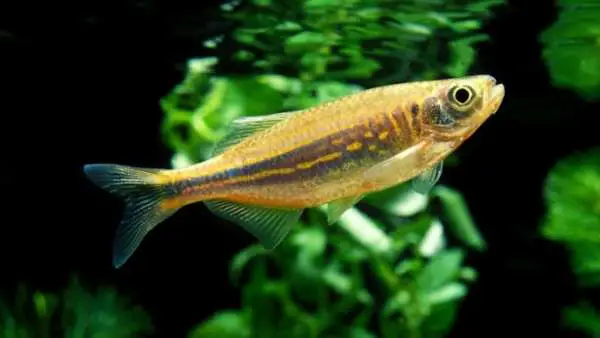
Due to their busy and somewhat hyperactive nature, they have been known to jump, so make sure your tank's lid is on and securely fastened. They also are serious swimmers and do need places to hide too, requiring a fair amount of attention. They do, however, entertain themselves and enjoy socializing with other fish of a similar size. They have also been known to sometimes join other schools within communities of a similar size!
Royal Blue Danio Overview
- They are an easy fish to manage, beginners and experts alike will have a lot of fun with this one.
- They have an incredibly peaceful personality and even enjoy socializing with other community members.
- They are omnivores.
- They will require a tank size of 10 Gallons or 39 Liters.
Final Words
In conclusion, there are a multitude of incredibly beautiful, and colorful freshwater fish. For some reason many assume to brighten up your tank via fish and their coloration you have to simply look at saltwater fish only, which couldn't be further from reality.
The fish that feature in this list are some of our favorites and are suitable for pretty much any stage you are at in your aquarium and fish keeping journey. However, there are others that haven't been mentioned, and if you want to have a vibrant freshwater aquarium you can do so without the expensive saltwater fish and their specific requirements.
